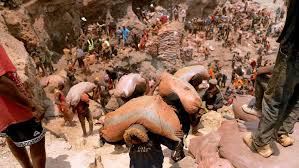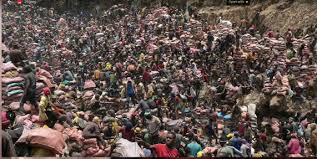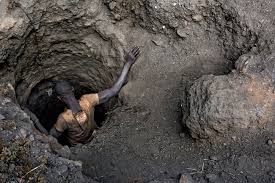Congo Blood Powers Our Electric Vehicles and Cell Phones
Cobalt Red; How the Blood of the Congo Powers Our Lives, Siddharth Kara, 2023
One must acknowledge, however, the following crucial fact—for centuries, enslaved Africans was the nature of colonialism. In the modern era, slavery has been universally rejected and basic human rights are deemed egra omnes and jus congens in international law. The ongoing exploitation of the poorest people of the Congo by the rich and powerful invalidates the purported moral foundation of contemporary civilization and drags humanity back to a time when the people of Africa were valued only by their replacement cost.
The harsh realities of cobalt mining in the Congo are an inconvenience to every stakeholder in the chain. No company wants to concede that the rechargeable batteries used to power smartphones, tablets, laptops, and electric vehicles contain cobalt mined by peasants and children in hazardous conditions.
As scrutiny over the conditions under which cobalt is mined has increased, stakeholders have formulated international coalitions to help ensure that their supply chains are clean. The two leading coalitions are the Responsible Minerals Initiative (RMI) and the Global Battery Alliance (GBA)…In all my time in the Congo, I never saw or heard of any activities linked to either of these coalitions, let alone anything that resembled corporate commitments to international human rights standards, third party audits, or zero-tolerance policies on forced child labor. On the contrary, across twenty-one years of research into slavery and child labor, I have never seen more extreme predation for profits than I witnessed at the bottom of global cobalt supply chains…Our daily lives are powered by a human and environmental catastrophe in the Congo.
The truth, however, is this—but for their demand for cobalt and the immense profits they accrue through the sale of smartphones, tablets, laptops, and electric vehicles, the entire blood-for-cobalt economy would not exist.
No one knew at the outset that the Congo would prove home to some of the largest supplies of almost every resource the world desired, often at the time of new inventions or industrial developments—ivory for piano keys, crucifixes, false teeth, and carvings (1880s), rubber for car and bicycle tires (1890s), palm oil for soap (1900s), copper, tin, zinc, silver, and nickel for industrialization (1910s), diamonds and gold for riches (always), uranium for nuclear bombs (1945), tantalum and tungsten for microprocessors (2000s), and cobalt for rechargeable batteries (2012+)…At no point in their history have the Congolese people benefited in any meaningful way from the monetization of their country’s resources. Rather, they have often served as slave labor force for the extraction of those resources at minimum cost and maximum suffering.
The battery packs in electric vehicles require up to 10 kilograms of refined cobalt each, more than a thousand times the amount required for a smartphone battery. As a result, demand for cobalt is expected to grow by almost 500 percent from 2018 to 2050, and there is no known place on earth to find that amount of cobalt other than the DRC (Democratic Republic of Congo).
As of 2022, there is no such thing as a clean supply chain of cobalt from the Congo. All cobalt sources from the DRC is tainted by various degrees of abuse, including slavery, child labor, forced labor, debt bondage, human trafficking, hazardous and toxic working conditions, pathetic wages, injury and death, and incalculable environmental harm. Although there are bad actors at every link in the chain, the chain would not exist were it not for the substantial demand for cobalt created by the companies at the top.
The industrial mining operations in the DRC are typically structured as joint ventures between the state owned mining company, Gecamines, and a foreign mining company. As of my last ground count in November 2021, there were nineteen major copper-cobalt companies operating in Haut_Katanga and Lualaba provinces, fifteen of which were owned or financed by Chinese mining companies. Most of the Chinese-owned mining sites I visited were secured either by a military force called the FARDC or the elite Republican Guard.
In 2021 China produced 75 percent of the world’s refined cobalt…The largest lithium-ion battery manufacturers in the world are CATL and BYD in China, LG Energy Solution, Samsung SDI, and SK Innovation in South Korea, and Panasonic in Japan. In 2021, these six companies produced 86 percent of the world;s lithium-ion rechargeable batteries, with CATL alone holding one-third of global share.
Gloria, a student at the University of Lubumbashi:
“Let me tell the most important thing that no one is discussing. The mineral reserves in Congo will last another forty years, maybe fifty? During that time, the population of Congo will double. If our resources are sold to foreigners for the benefit of the political elite, instead of investing in education and development for our people, in two generations, we will have two hundred million people who are poor, uneducated, and have nothing left of value. This is what is happening, and if it does not stop, it will be a disaster.”
Industrial mining is like doing surgery with a shovel. Artisanal mining is like doing it with a scalpel. During industrial excavation, tons of dirt, stone, and ore are gathered indiscriminately with large machinery, crushed down to pebbles, and processed to extract minerals of value. It is by design a blunt-force, low-yield, high-volume business. Artisanal miners, on the other hand, can use more precise tools to dig or tunnel for high-grade deposits of ore, extract only the ore, and leave the value-less dirt and stones behind…Artisanal mining techniques can yield up to ten or fifteen times a higher grade of cobalt per ton than industrial mining can.



